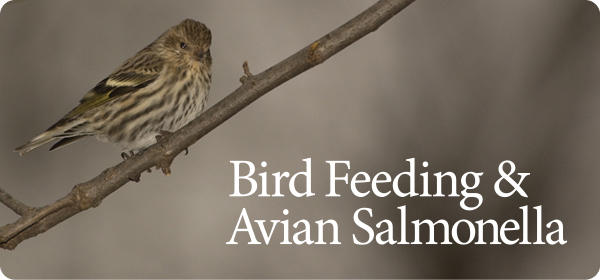Salmonella- KEEPING SAFE & Clean
Be a Responsible Bird Feeder & Keep Song Birds Safe
What is Avian Salmonella?
Avian Salmonella is caused by a bacteria and is an uncommon cause of mortality in feeder birds. Occasionally, outbreaks of the disease cause significant mortality in certain species including Pine Siskin, Common Redpoll, and American Goldfinch.
What should I look for at my feeders?
Sick birds may appear thin or fluffed up and may have swollen eyelids. They are often lethargic and are easy to approach.
How is Avian Salmonella spread?
Salmonellosis is primarily transmitted by fecal contamination of food and water by sick birds, though it also can be transmitted by bird-to-bird contact during daily interactions and while roosting.
What should I do to keep my birds safe?
• If you are NOT seeing any birds with symptoms, continue to feed your birds, but with extra diligence in keeping your feeders and feeding area clean.
• Scrub all your bird feeders, bird baths and hardware with soap and water, then sanitize with a 10% bleach (one part bleach to nine parts water) solution. Rinse thoroughly and allow to completely dry before refilling feeders. Repeat this cleaning every few days.
• Rake up and discard seed debris and bird droppings from the ground below and around feeders. Continue to clean these areas on a regular basis.
• Avoid handling sick birds and always wash your hands with soap and water after filling bird feeders.
The National Wildlife Health Center
Eight Steps to Prevent or Minimize Disease Problems at Feeders
1. Give them space - Avoid crowding by providing ample feeder space. Lots of birds using a single feeder looks wonderful, but crowding is a key factor in spreading disease. If birds have to jostle each other to reach the food, they are crowded. This crowding also creates stress which may make birds more vulnerable to disease.
2. Clean up wastes - Keep the feeder area clean of waste food and droppings. A broom and shovel can accomplish a lot of good, but a vacuum such as you might use in your garage or workshop will help even more.
3. Make feeders safe - Provide safe feeders without sharp points or edges. Even small scratches and cuts will allow bacteria and viruses to enter otherwise healthy birds.
4. Keep feeders clean - Clean and disinfect feeders regularly. Use one part of liquid chlorine household bleach in nine parts of tepid water (a 10 percent solution) to disinfect. Make enough solution to immerse an empty, cleaned feeder completely for two to three minutes. Allow to air dry. Do this weekly for the time being or if you see sick birds at your feeder, every 1-2 days.
5. Use good food - Discard any food that smells musty, is wet, looks moldy or has fungus growing on it. Disinfect any storage container that holds spoiled food and the scoop used to fill feeders from it.
6. Prevent contamination - Keep rodents out of stored food. Mice can carry and spread some bird diseases without being affected themselves.
7. Act early - Don't wait to act until you see sick or dead birds. With good prevention you'll seldom find sick or dead birds at your feeders.
8. Spread the word - Encourage your neighbors who feed birds to follow the same precautions. Birds normally move among feeders and can spread diseases as they go. The safest bird feeders will be those in communities where neighbors cooperate with equal concern for the birds.
The Complete Story- birds do get sick. Disease is one of many natural processes affecting wild species. Sick birds do show up at feeders, and other birds can get sick as a consequence. Just because bird feeding is not problem-free does not mean that it is bad or should be stopped.
It does mean you have an ethical obligation not to jeopardize wild birds. What is called for is intelligent bird feeding. Follow the precautions listed above, and you can continue to enjoy feeding healthy wild birds. Bird feeding seems like the perfect outdoor activity. People can learn a lot while they enjoy helping birds. As ideal as bird feeding may seem, it carries some risk for birds that visit the feeders and some responsibility for people who do the feeding.
Additional info from a store owner in Oregon:
Salmonella in Wild Birds
Dan Gleason, 2021
Ornithology Instructor, retired, University of Oregon, Co-owner Wild Birds Unlimited, Eugene, Oregon
Taking down your feeders is not really a solution to a Salmonella outbreak. It simply moves the problem to someone else’s feeders. If most of the feeders in a given area are removed, the problem may actually increase as more birds congregate around the few remaining feeders.
Tray feeders are the worst offenders as droppings quickly accumulate on their surfaces. You may wish to consider removing trays, and only have other types of feeders, such as tube feeders, up until the problem disappears. Be sure to clean any tray feeder before reusing it. A thorough cleaning, as directed above, is most helpful in controlling the problem.
If you have several feeders, you might want to reduce the number you have up. If you don’t wish to take the time to clean the feeders, then it is best to bring them down to prevent further spread of infection. A good one-time cleaning, followed by frequent, but less intense, feeder cleanings should be sufficient to control the problem in your yard. Bird feeding does come with the responsibility to maintain a clean and healthy feeding area, and during Salmonella outbreaks you may need to expend some extra effort.


